Problem Statement
Given an array nums of size n, which denotes the positions of stalls, and an integer k, which denotes the number of aggressive cows, assign stalls to k cows such that the minimum distance between any two cows is the maximum possible. Find the maximum possible minimum distance.
Examples
Example 1:
Input: nums = [0, 3, 4, 7, 10, 9], k = 4
Output: 3
Explanation: The maximum possible minimum distance between any two cows will be
3 and 4 cows are placed at positions [0, 3, 7, 10].
Here the distances between cows are 3, 4, and 3 respectively. We cannot make the minimum distance greater than 3 in any ways.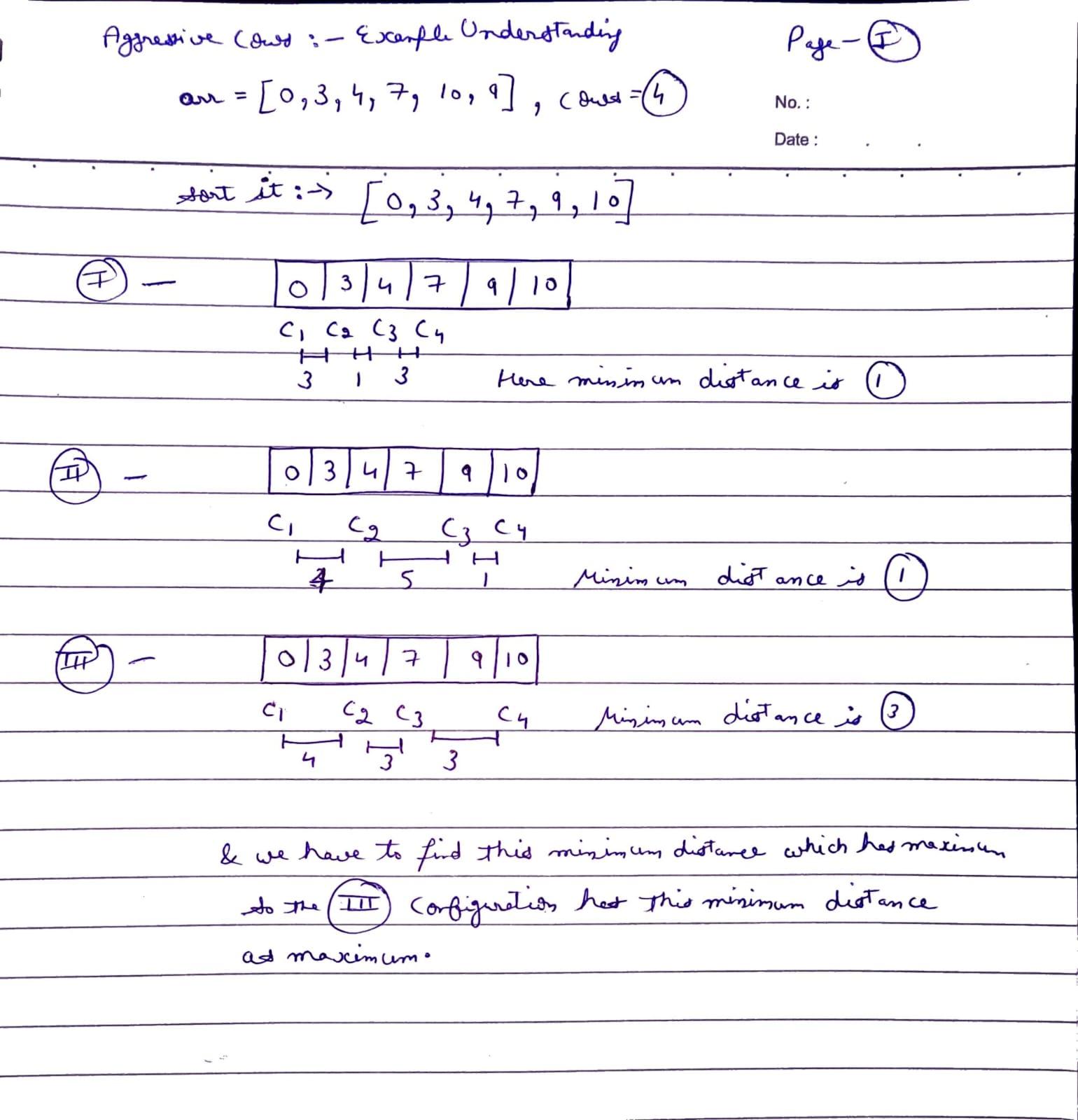
Example 2:
Input: nums = [4, 2, 1, 3, 6], k = 2
Output: 5
Explanation:
First sort the array: [1, 2, 3, 4, 6] to make it easier to calculate
the distances between stalls.
We have to place two cows.
For distance 1: c1 can be at 1 and c2 be at 2, the difference is 1
For distance 2: c1 can be at 1 and c2 be at 3, the difference is 2
For distance 3: c1 can be at 1 and c2 be at 4, the difference is 3
For distance 5: c1 can be at 1 and c2 be at 6, the difference is 5
The largest possible minimum distance between any two cows is 5,
achieved by placing one cow at position 1 and the other at position 6.Different Approaches
1️⃣ Brute Force (Linear Search):
Intuition:
The extremely naive approach is to use linear search to check all possible distances from 1 to (max-min), where max is the maximum element of the array and min is the minimum element of the array. The maximum distance for which the cows can be placed, will be our answer.
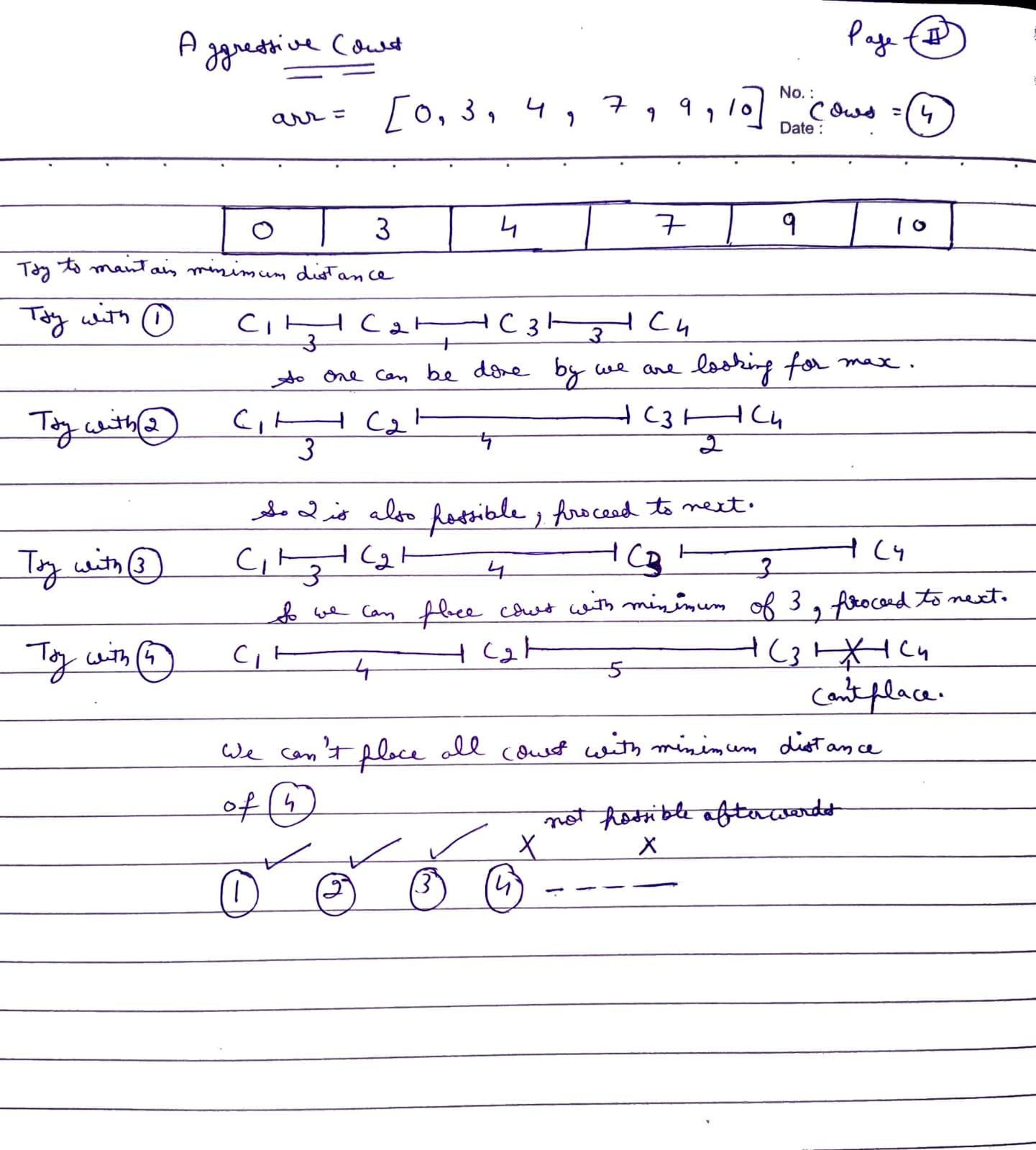
Code:
#include <bits/stdc++.h>
using namespace std;
class Solution {
private:
/* Function to check if we can place 'cows' cows
with at least 'dist' distance apart in 'stalls' */
bool canWePlace(vector<int> &nums, int dist, int cows) {
// Size of array
int n = nums.size();
// Number of cows placed
int cntCows = 1;
// Position of last placed cow
int last = nums[0];
for (int i = 1; i < n; i++) {
if (nums[i] - last >= dist) {
// Place next cow
cntCows++;
// Update the last location
last = nums[i];
}
if (cntCows >= cows) return true;
}
return false;
}
public:
/* Function to find the maximum possible minimum
distance 'k' cows can have between them in 'stalls' */
int aggressiveCows(vector<int> &nums, int k) {
// Size of array
int n = nums.size();
// Sort the nums
sort(nums.begin(), nums.end());
int limit = nums[n - 1] - nums[0];
for (int i = 1; i <= limit; i++) {
if (canWePlace(nums, i, k) == false) {
return (i - 1);
}
}
//Retrun the answer
return limit;
}
};
int main() {
vector<int> nums = {0, 3, 4, 7, 10, 9};
int k = 4;
// Create an instance of the Solution class
Solution sol;
int ans = sol.aggressiveCows(nums, k);
// Output the result
cout << "The maximum possible minimum distance is: " << ans << "\n";
return 0;
}
Complexity Analysis:
- Time Complexity:
O(N log N) + O(N * (max - min)), whereNis size of the array,maxis the maximum element in array,minis the minimum element in array.O(N log N)for sorting the array.- The outer loop runs for
1to (max-min) to check all possible distances. - The inner loop runs for
Ntimes.
- Space Complexity:
O(1)
2️⃣ Binary Search
This is the starting of another pattern of the binary search on answer
- min of max
- max of min
Intuition:
The idea is to use binary search as the search range from [1, max - min] is sorted.
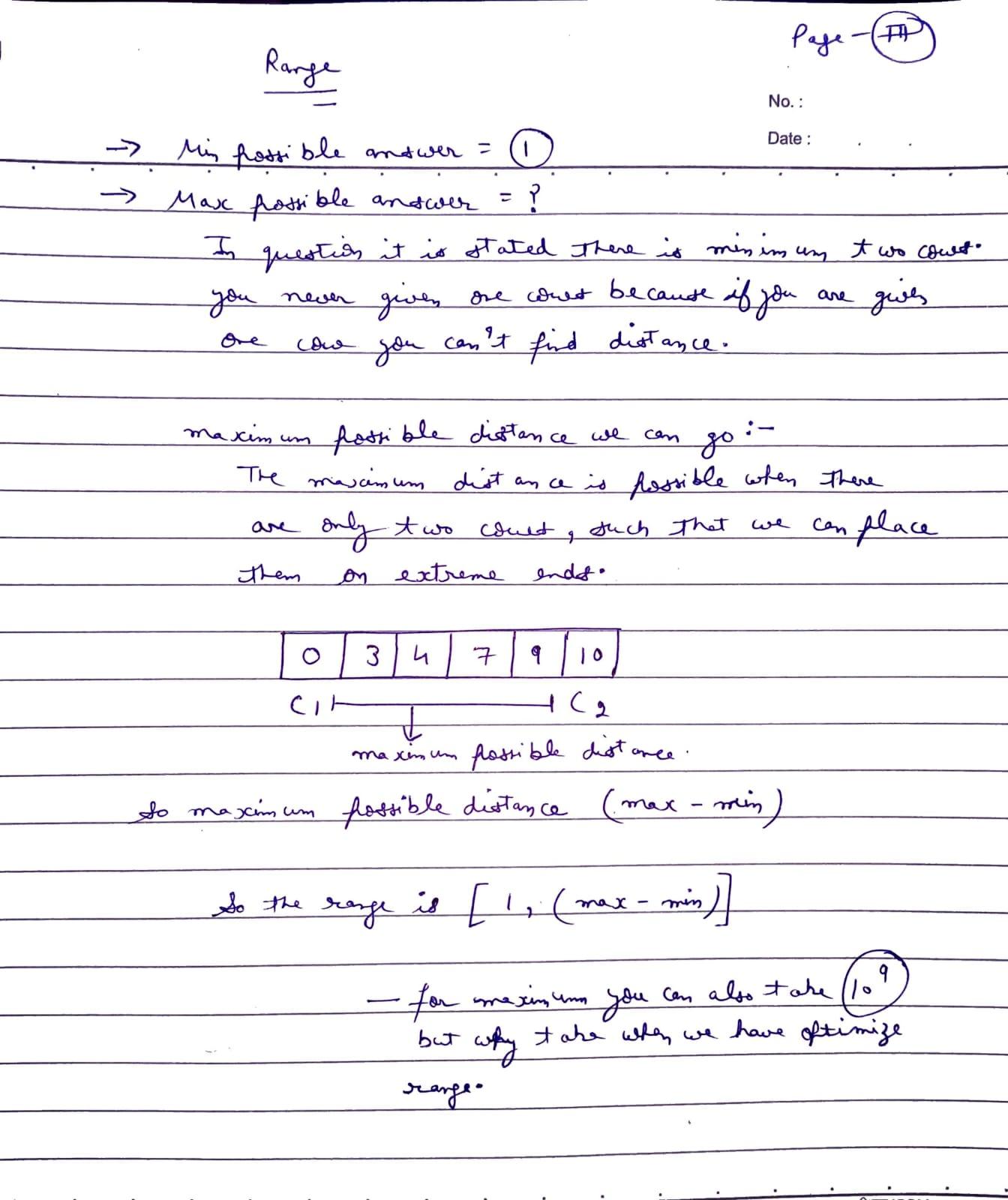
Dry Run:
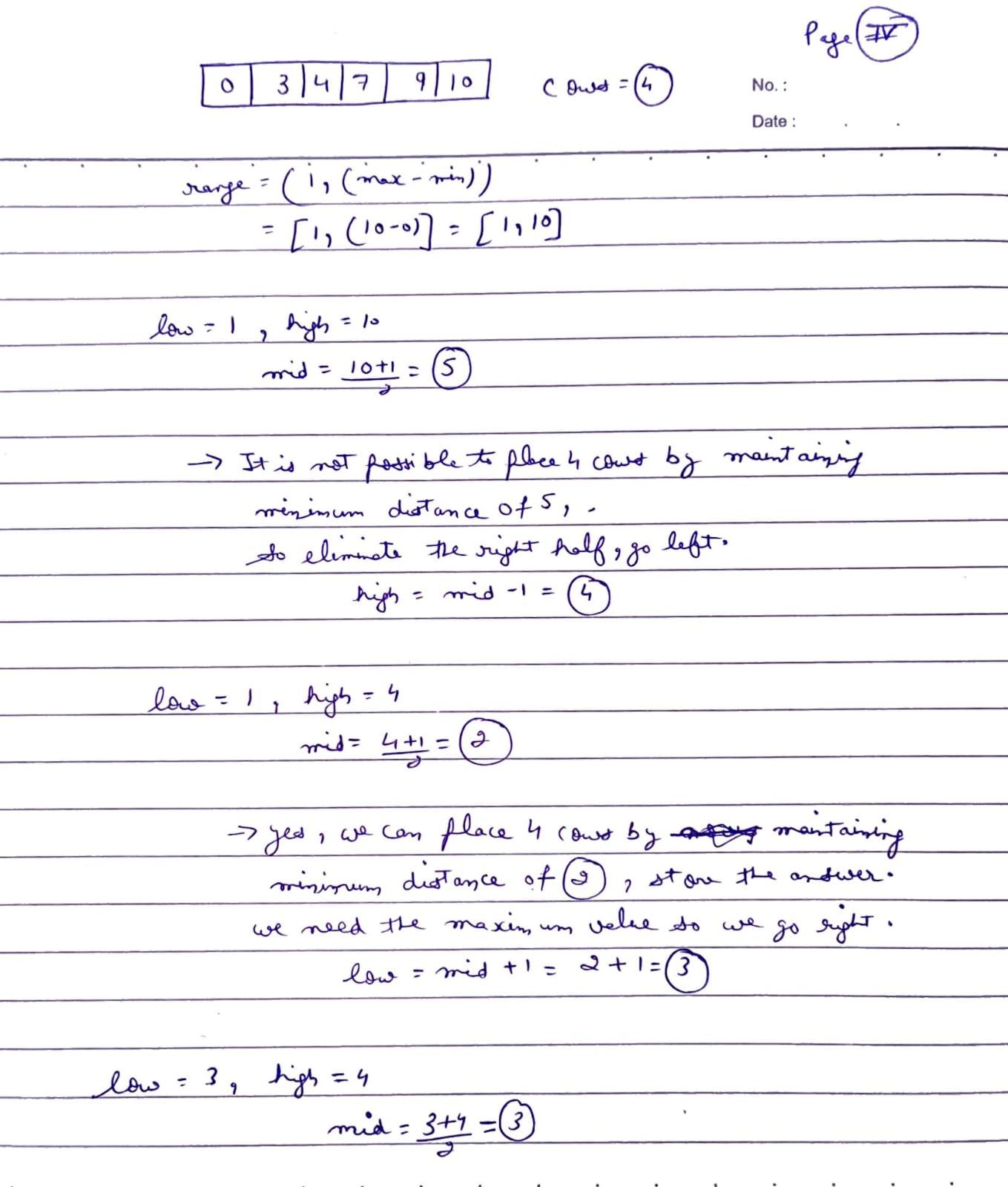
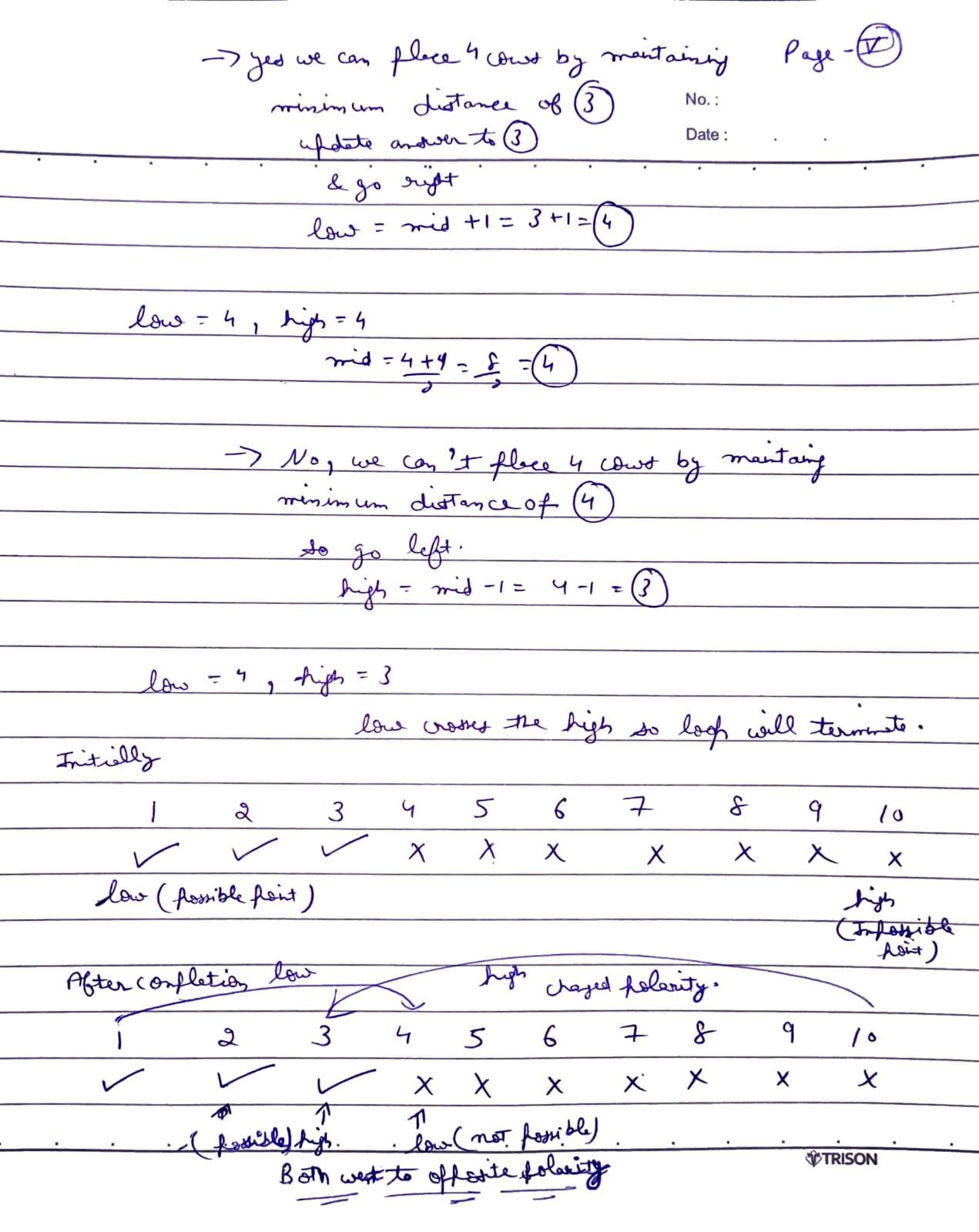
Code:
#include <bits/stdc++.h>
using namespace std;
class Solution {
private:
/* Function to check if we can place 'cows' cows
with at least 'dist' distance apart in 'stalls' */
bool canWePlace(vector<int> &nums, int dist, int cows) {
// Size of array
int n = nums.size();
// Number of cows placed
int cntCows = 1;
// Position of last placed cow
int last = nums[0];
for (int i = 1; i < n; i++) {
if (nums[i] - last >= dist) {
// Place next cow
cntCows++;
// Update the last location
last = nums[i];
}
if (cntCows >= cows) return true;
}
return false;
}
public:
/* Function to find the maximum possible minimum
distance 'k' cows can have between them in 'stalls' */
int aggressiveCows(vector<int> &nums, int k) {
// Size of array
int n = nums.size();
// Sort the nums
sort(nums.begin(), nums.end());
int low = 1, high = nums[n - 1] - nums[0];
//Apply binary search:
while (low <= high) {
int mid = (low + high) / 2;
if (canWePlace(nums, mid, k) == true) {
low = mid + 1;
}
else high = mid - 1;
}
return high;
}
};
int main() {
vector<int> nums = {0, 3, 4, 7, 10, 9};
int k = 4;
// Create an instance of the Solution class
Solution sol;
int ans = sol.aggressiveCows(nums, k);
// Output the result
cout << "The maximum possible minimum distance is: " << ans << "\n";
return 0;
}
Complexity Analysis:
- Time Complexity:
O(N log N) + O(N * log(max-min)), whereNis the size of the array,maxis the maximum element in array,minis the minimum element in array.O(N logN): for sorting the array.O(log (max-min)): The outer loop.O(N): The inner loop runs forNtimes.
- Space Complexity:
O(1)
